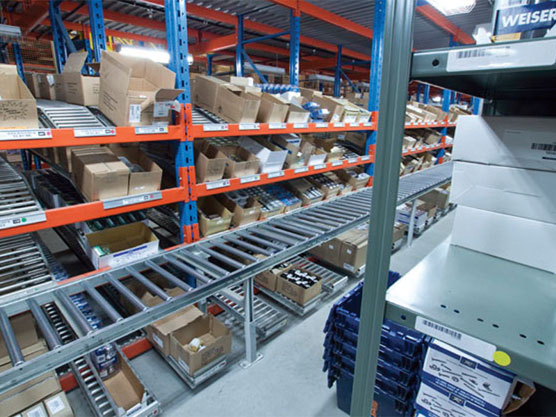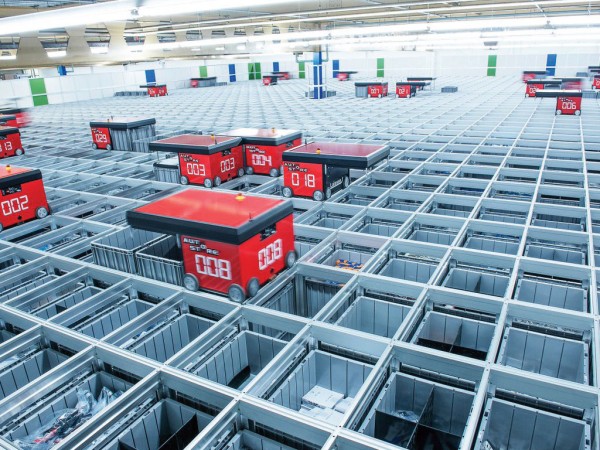Warehousing around the globe is undergoing a dramatic change with the widespread introduction of automation. But as the Ocado facilities illustrate, warehouse automation is much more than conveyor belts and racks.
By Matt Miller, AJOT
This operation is the domain of Ocado, the British online grocer. In its Andover facility, Ocado has literally turned the traditional warehouse on its head: There are no cases of goods weighing down traditional racks, just thousands and thousands of bins stacked in a 20-foot-high latticework, floor to almost ceiling. The robots skirt the ceiling of the building and work not from the ground up, but from the top down. They don’t move in a linear fashion like an assembly line or conveyor belt. Instead, they travel like pieces on a chessboard, up and down, back and forth. The company refers to this system as a hive.
This new system reduces the time it takes to fill an average order from two hours, in Ocado’s old warehouse, to five to 15 minutes.

“It’s a drastic acceleration of the assembly of the binning and packing of the order,” said Alex Voica, Ocado’s head of technology PR and communications.
Ocado is now constructing a much bigger facility in Erith, southeast of London. This warehouse will top 560,000 square feet, more than twice the size of Andover. It will employ 3,500 robots. When fully functional, the warehouse will fill more than 200,000 orders in a week, more than three times Andover’s throughput. Ocado believes it will be the world’s largest automated warehouse for groceries. Its price tag is a jaw-dropping £250 million, according to its construction contractor Bericote.
Ocado also is designing and building automated warehouse operations employing its robots for other grocers. These include Casino in France, ICA in Sweden and Sobeys in Canada. In May, Ocado announced its biggest deal yet, designing and providing systems for automated warehouses for the American supermarket behemoth Kroger Co. Kroger, which will invest some $250 million in Ocado through new shares as part of the deal, said it will try to identify three initial sites this year, with the possibility of 20 automated warehouses in total.
Ocado’s efforts represent a radical rethink of the warehouse, with robots firmly in the lead. Ocado isn’t alone. China’s online retailers Alibaba and JD.com have built robot-centric, technologically advanced, almost-fully automated warehouses. And, of course, Amazon employs thousands of robots in its fulfillment centers. Amazon decided the robots were so vital to its future that it bought the robot manufacturer, Kiva Systems.
The Robotic Cube
The pioneer in Ocado’s approach to robotics is a Danish company now called AutoStore, which developed its robotic cube storage system almost 20 years ago. “We see a big boom” in business, said Marketing Director Magne Hatteland.
Both Ocado and AutoStore employ a sophisticated controller system that deploys the robots traveling at great speed to the proper bin locations. Robots communicate with each other to prevent collisions, since they pass within millimeters of each other. But the robots don’t have to identify what are in the bins they pick, so they don’t need scanners or, say, RFID technology. “We maintain a complex supply chain system we developed ourselves which keeps track of everything in the warehouse: inbound and outbound, based on barcodes,” said Voica. “Therefore, we know where every single product is in the hive and can thus send our robot fleet to retrieve it from the stack of bins.”
Ecommerce in particular demands the kind of speed, efficiency and accuracy that automation can bring and has really been the driving force behind much of warehouse robotics. Some 40% of AutoStore’s customers are in ecommerce. However, companies utilizing AutoStore robotics also include Lufthansa, Puma and medical products manufacturer and distributor Medline.

Both AutoStore and Ocado promote their robots and saving significant space, creating huge gains in efficiency saving time, and being scalable.
A traditional warehouse racks their goods at best halfway to the ceiling, whereas these systems use every inch of available space. This creates four times the storage capacity, said Hatteland, allowing for smaller warehouses, attractive especially where real estate is expensive.
Because these systems are modular, they don’t need to be fully installed day one. “You can keep expanding and expanding and expanding,” said Voica.
According to Hatteland, AutoStore systems can operate in buildings of any size and shape and the robots and aluminum grids are easily transportable from one facility to another. Smaller operations “don’t have to plan for a warehouse that is running in 2024 on Black Friday. They can buy for the exact situation they are today and then just add robots or bins, Hatteland said.
Are these operations vanguards of something entirely new and revolutionary in warehousing and distribution as a whole? Promoters such as Ocado and AutoStore believe they are. “We will see a change from traditional warehouses to automated warehouses, without a doubt,” said Hatteland, although he’s quick to add: “Of course the degree of automation will vary significantly.”
Some Analysts Counter not so Fast
“It’s definitely a slow process,” Samuel Demont, a senior manager with the Paris-based consulting company Argon. “The warehouse manager of tomorrow will be someone who knows how to manage both people and machines, while in the past, the warehouse business was people. But the warehouse, itself, I don’t see it being so different,” said Demont.
With the price of robots decreasing, and their sophistication, functionality and dependability increasing, automation is definitely on the rise. Logistics is no exception. Warehousing is experiencing more and more robotics. However, robots tend to co-exist alongside traditional distribution methods, within standard warehouses, and will continue to do so for some time to come, many believe.
“There is no doubt that automated projects are occurring more frequently, that the availability for these kinds of systems no longer are for the chosen few,” said Martin McVicar, in an email. McVicar is managing director of the Irish forklift manufacturer CombiLift, whose company now has an entire division designing warehouses. “We are seeing an increase in requests on automated warehouses, with new as well as existing clients. But in most cases clients are going after the soft start, where the automated part is being implemented as a stand-alone solution – having the traditional warehouse fully operative on the side.”
The structure of warehouses operations and their ownership help explain some of the resistance. For example, 3PLs handle more and more logistical needs, including warehousing. However, contracts usually last for only three years, far less time than return on a significant investment in robotics. So, it’s tough to justify, although AutoStore is gaining some success selling its system to 3PLs that can in turn allocate bins to a number of clients, big and small.
The type of goods being moved, frequency of movement on and off shelves, even the shape of the items, all help determine the degree automation is viable. “In most cases, our clients are handling volume, either through high throughput of pallets – or long and awkward loads,” said McVicar. “Most of our clients have different order structures as well as extreme seasonal fluctuation, and therefore require a flexibility that a fully automated system would have a hard time to handle – and if even possible to handle would be difficult to establish a viable business case with a satisfactory return of investment.”
The Human Touch
Even at Ocado, humans continue to unpack pallets, break cases and drive forklifts of goods, although the company is currently discussing the employment of automated guidance vehicles with a British technology company called Oxbotica, according to Voica. He added that the frozen food section of the warehouse still depends on traditional racks and human pickers, as robots can’t function in extreme cold.
One thing just about everyone agrees on is that logistics demands far more flexibility than in manufacturing, where robots have gained a more significant toehold. In many cases, the warehouse robot must be more sophisticated because the environment is so dynamic.
“Automation within manufacturing and production is much easier to plan, given that a constant material flow is lined up from day one. Within logistics, the challenges are really and truly that NOTHING is predictable: What do we have on the shelves tomorrow? What’s the throughput? What’s the market demand? All [are] factors which require a great deal of flexibility,” McVicar wrote.

Advocates say that as time goes on, logistics operators will feel increased pressure to automate. “To have all these inaccurate processes, where people have to look for products, where a lot of errors can happen, a lot of time is consumed, it’s getting more and more inefficient,” said Hatteland.
“In five years there will be a lot more robot arms instead of human arms.”


